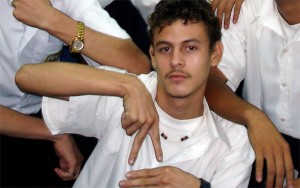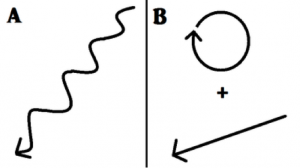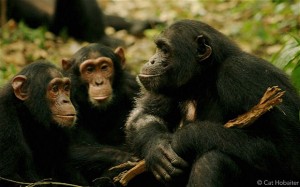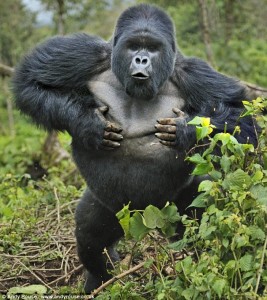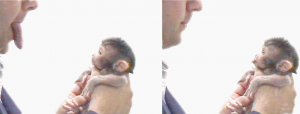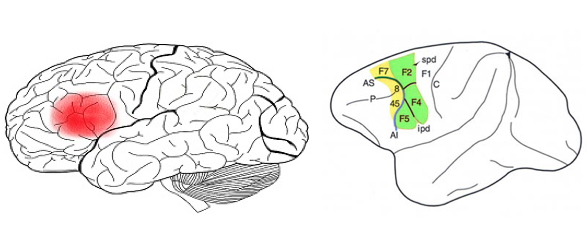5. Conclusion
We have introduced gestures in this topic of language evolution by exploring the different types of gestures, namely representational gestures, beat gestures and interactive gestures. In both infants and animals, imitating gestures is a way of learning how to communicate. Infants imitate to match what they see to what they do, while animals imitate as a form of social learning – by imprinting behaviors from an adult or peer to a child.
We also discussed about the popular Gestural Theory in the evolution of language, comparing that to the Theory of Language in terms of human communication. To sum up, The Gestural Theory provides a wide range of evidence accounting for the precedence of gestures over speech in the origins of language, garnering support and backing by many linguists and evolutionists. For example, neurophysiological evidence provided by mirror neurons supports the development of language from gestures. The vast amount of research done on gesturing in animal communication and the homology in mirror systems in the brain have supported that gestures served as an important means of primate communication before vocalizations ultimately led to speech. Gestures in animals, in particular non-human primates, are hence important in providing evidence of this form of primate communication before vocalizations were possible. Studies done on both apes and monkeys support the communicative functions of gesturing in animals, with its wide variety of gesture repertoires providing clues to speech repertoires today.
The case study on Nicaraguan Sign Language (NSL) provides an interesting insight on how home sign systems and gestures have resulted in the birth of a new language across two cohorts of children, following the formation of a deaf community in Nicaragua. It shows just how impactful gestures and signs are in our world, where languages are constantly evolving over time.
We hope you have gained greater insight on gestures as a mode of communication present not only before vocalization and speech, but have also been integrated into our communication systems today as a supplement to speech.
6. References
Alibali, M. W., Heath, D. C., & Myers, H. J. (2001). Effects of visibility between speaker and listener on gesture production: Some gestures are meant to be seen. Journal of Memory and Language, 44(2), 169-188. doi:10.1006/jmla.2000.2752
Arbib, M. A., Liebal, K., & Pika, S. (2008). Primate vocalization, gesture, and the evolution of human language. Current Anthropology, 49(6), 1053-1076. doi:10.1086/593015
Bekkering, H., Wohlschlager, A., & Gattis, M. (2000). Imitation of gestures in children is goal-directed. Quarterly Journal of Experimental Psychology Section A, 53(1), 153-164. doi:10.1080/027249800390718
Brooks-Pollock, T. (2014). The 66 gestures which show how chimpanzees communicate. Retrieved April 2, 2015, from http://www.telegraph.co.uk/news/science/10945811/The-66-gestures-which-show-how-chimpanzees-communicate.html
Corballis, M. C. (2002). From hand to mouth, the origins of language. Princeton: Princeton University Press.
Fay, J. M. (1989). Hand-clapping in western lowland gorillas (Gorilla gorilla gorilla). Mammalia, 53(3).
Fogassi, L., & Ferrari, P. F. (2004). Mirror neurons, gestures and language evolution. Interaction Studies, 5(3), 345-363. doi:10.1075/is.5.3.03fog
Gillespie-Lynch, K., Greenfield, P. M., Feng, Y., Savage-Rumbaugh, S., & Lyn, H. (2013). A cross-species study of gesture and its role in symbolic development: Implications for the gestural theory of language evolution. Frontiers in Psychology, 4.
Goodall, J. (1986). The Chimpanzees of Gombe: Patterns of behaviour. Cambridge: Belknap.
Hobaiter, C. & Byrne, R. W. (2014). The Meanings of Chimpanzees Gestures. Current Biology, 24(14), pp. 1596-1600.
Kohler, E., Keysers, C., Umilta, M. A., Fogassi, L., Gallese, V., & Rizzolatti, G.(2002). Hearing Sounds, Understanding Actions: Action Representation in Mirror Neurons. Science, 297, pp. 846-858.
Kimura, D. (1993). Neuromotor mechanisms in human communication. Oxford: Oxford
University Press.
Kummer, H. (1968). Social organization of hamadryas baboons. Chicago: University of Chicago Press.
Maestripieri, D. (1999). Primate social organization, gestural repertoire size, and communication dynamics. The origins of language: What nonhuman primates can tell, pp. 55-77.
McLane, J. (1996). The voice on the skin: Self-mutilation and merleau-ponty’s theory of language. Hypatia, 11(4), 107-118.
McNeill, D. (1985). So you think gestures are nonverbal? Psychological Review, 92(3), 350-371. doi:10.1037//0033-295X.92.3.350
Meltzoff, A. N., & Moore, M. K. (1977). Imitation of facial and manual gestures by human neonates. Science, 198(4312), 75-78. doi:10.1126/science.897687
Morgan, G., & Kegl, J.(2006). Nicaraguan Sign Language and Theory of Mind: the issue of critical periods and abilities. Journal Of Child Psychology & Psychiatry, 47(8), 811-819. doi:10.1111/j.1469-7610.2006.01621.x
Ogden, J. & Schildkraut, D. (1991). Compilation of gorilla ethograms. Atlanta: Gorilla Behavior Advisory Group.
Paget, R. A. S. (1963). Human speech: Some observations, experiments and conclusions as to the nature, origin, purpose and possible improvement of human speech.
Parnell, R. J., & Buchanan-Smith, H. M. (2001). Animal behaviour: An unusual social display by gorillas. Nature, 412(6844).
Pika, S. (2008). Gestures of apes and pre-linguistic human children: Similar or different? First Language, 28(2), 114-140. doi:10.1177/0142723707080966
Redshaw, M. & Locke, K. (1976). The development of play and social behaviour in two lowland gorilla infants. Journal of the Jersey Wildlife Preservation Trust, Thirteenth Annual Report, pp. 71-86.
Senghas, A., & Coppola, M. (2001). Children Creating Language: How Nicaraguan Sign Language Acquired a Spatial Grammar. Psychological Science (Wiley-Blackwell), 12(4),
Senghas, A., Kita, S., & Özyürek, A. (2004). Children Creating Core Properties of Language: Evidence from an Emerging Sign Language in Nicaragua. Science, 305(5691), 1779-1782.
Skoyles, J. R. (2000). Gesture, language origins, and right handedness. Psycoloquy, 11(24).
Zentall, T. R., & Akins, C. (2001). Imitation in animals: Evidence, function, and mechanisms. Cybernetics and Systems. doi:10.1080/019697201300001812


